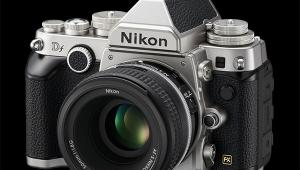Canon EOS 70D DSLR Review
The Canon EOS 70D is a 20MP APS-C-sized sensor camera that has a massive body with a large grip on its right-hand side that makes for very comfortable handling. It has a classic SLR design with an optical viewfinder with numerous function buttons, and a fully articulated large, touch-sensitive LCD screen on its back (it can be flipped up- and downward and turned to the side) that is very handy, especially in video recording mode.





The function buttons allow for easy operation: the “Q” button opens the quick menu and helps with fast set up of the most important image parameters. There are also two dials (one near the shutter release button, the second on the back at the eight-way control field) that can be used. The large mode dial on the top provides direct access to all exposure programs, a user-defined mode (“C”), and scene modes like “portrait shot.” In addition to scene modes the camera offers additional effect modes like “fish eye,” “grain,” “toy camera,” and “painting.”
The status LCD on the top is illuminated and shows all the settings: aperture, shutter speed, image mode, file mode (JPEG, Raw, or JPEG/Raw combination), battery status, EV compensation, and more.
The camera has a new AF system. In still image mode it uses 19 AF sensors, which showed a very fast performance in our tests; all are “cross-type” sensors. In addition, the camera offers a new AF system for video recording. The “Dual Pixel CMOS AF” splits every sensor diode into two areas and uses one area for focusing, which yields very fast focusing and focus tracking while recording video. The system worked very well in our tests.
The camera also offers some very special image modes, like “HDR.” In this mode three pictures with different exposure settings are made and combined to one HDR file. The photographer can set up the exposure bias between the single images to 1, 2, or 3 EVs.
The camera also offers an integrated WLAN module. Apps for Android and iOS smartphones are available (for free) in Apple’s iTunes shop or Google’s Play Store. These apps allow for comfortable remote control of the camera.
The live preview can be seen on the smartphone, which offers full image control (exposure control, ISO speed settings, and more) and remote shooting.
The camera has an integral flash that can also work as a wireless remote control for external flash in Canon’s Speedlite series.

Comments On Still
Image Quality
Color: The color results are very good. The camera tends a little toward cooler colors (see gray patterns in result chart) and high saturation (110.6 percent, which is quite high even for a mid-range or entry-level SLR). Most color errors are on a low level and mostly based on the boosted saturation, which causes appreciable shifts of blue and red nuances, while all other colors have only minor aberrations. The skin tones are matched nearly perfectly which is noticeable in the portrait shot, while the red of the T-shirt is boosted and has a high yellow rate. The automatic white balance did a very good job under all lighting conditions.
Sharpness: The 70D showed a very good performance in our resolution and sharpness tests. The standard test chart was reproduced with 3326 lines in picture height (nominal sensor resolution: 3648 in picture height). The very high value is also a result of a very intense sharpness filtering (typical for Canon SLRs) which causes some halos/outline effects on hard contrast lines. The intense filtering is also noticeable in our standard test box shot and in the portrait shot. It is also visible in fine structures like the hairs in the portrait shot or the ruler and the Siemens stars in the standard test box shot.
Noise: The camera showed a very good performance in our noise tests. Just like other Canon cameras the 70D starts with slightly higher values for luminance noise in ISO 100, 200 and 400 settings, but also keeps this y-factor below 1.0 percent up to ISO 1600. The color noise is nearly perfectly filtered and the noise spectrum is very smooth. The single results for red, blue, and green are perfectly located on the same graphs in our result charts. In images taken with ISO 3200 to ISO 12,800 we noticed some anti-noise filtering artifacts, but they only decrease image details slightly.

Comments On Video Functions
The Canon EOS 70D records videos in Full HD resolution. It uses the Apple QuickTime format (MOV files) to save the videos. The camera uses different compression settings to enhance video quality or to create more space-saving video files. In standard mode it uses a standard with the H.264 compression technique, but it is also able to use an intra-frame compression setting. This means it saves every single frame as a key frame instead of an inter-frame system, which saves key frames and changes of content between those frames.
The camera uses very high data rates, but offers only standard frame rates like 25 or 30 (progressive) frames per second in Full HD; 720 resolution is recorded with a maximum of 50 or 60 frames per second. For the “ALL-I” mode it needs very fast SD cards with a minimum data rate of 20MB/second.
When recording video the EOS 70D offers all standard exposure modes like P, S, A, and M and allows for set up of ISO speed manually. Its new AF system, called “Dual Pixel CMOS AF,” uses the image sensor as an AF sensor and is very helpful when recording videos. Combined with an STM lens system, the 70D allows users to shoot AF videos with very fast AF tracking.
The camera also offers a continuous time code mode, which allows for synchronization of thevideo clips with clips of other camcorders or sound tracks recorded with additional sound recorders (like the Zoom H-6N, for example).
Due to the high sensor resolution the 70D offers an additional digital zoom in video mode which allows for image scaling by a factor of 3 to 10 in video mode. The 70D has no integrated image stabilizer system (just like all Canon SLRs) but the stabilizer systems of our test lenses worked well in our video tests.
The handling of the camera in video mode is very good. The camera has a start/stop switch on the back that is used for live preview in photo mode or as an additional shutter release button for video recording. The swivel LCD screen is very helpful and allows for comfortable image control when recording video.

Comments On Video Quality
The Canon showed typical aliasing and moiré problems in fine structures like in the roof tiles in our test shoot. Colors are very good—the camera showed only a very slight shift into cooler colors. The color errors are on a low level, skin tones are nearly perfect, and only our full yellow test pattern showed a significant aberration from its given value. The video resolution result is on an average level for SLR cameras (610.7 lines in picture height). The camera uses moderate sharpness enhancement settings for videos (contrary to the still JPEGs, which had significant over- and undershot effects due to the very intense sharpness filtering).
The dynamic range results in video mode are lower than in photo mode. The camera gained a maximum of nearly 10 f/stops (9.97 f/stops) which is less than the 11.2 f/stops which are shown in the still image tests.

Scorecard
Pro
+ Mid-range SLR system with high image quality
+ Massive body, very good finish
+ Very fast AF system, especially in video mode (new “Dual Pixel CMOS AF”)
+ Swivel monitor with high resolution
+ WLAN for remote control by smartphone/tablet PC or for direct connection to a WLAN in a studio
Con
- Optical viewfinder shows 98 percent field of view while competitive cameras in this class offer 100 percent field of view
Image Tech is where we publish web-exclusive lab reports on cameras. To read the reports please go to the Shutterbug homepage at www.shutterbug.com and click on the Image Tech tab on the top navigation bar. New reports are published frequently, so check Image Tech for updates.
Lab results and test images by BetterNet, our TIPA-affiliated testing lab. Edited by George Schaub.
The Canon EOS 70D has a list price of $1199. For more information, visit www.usa.canon.com.

















































